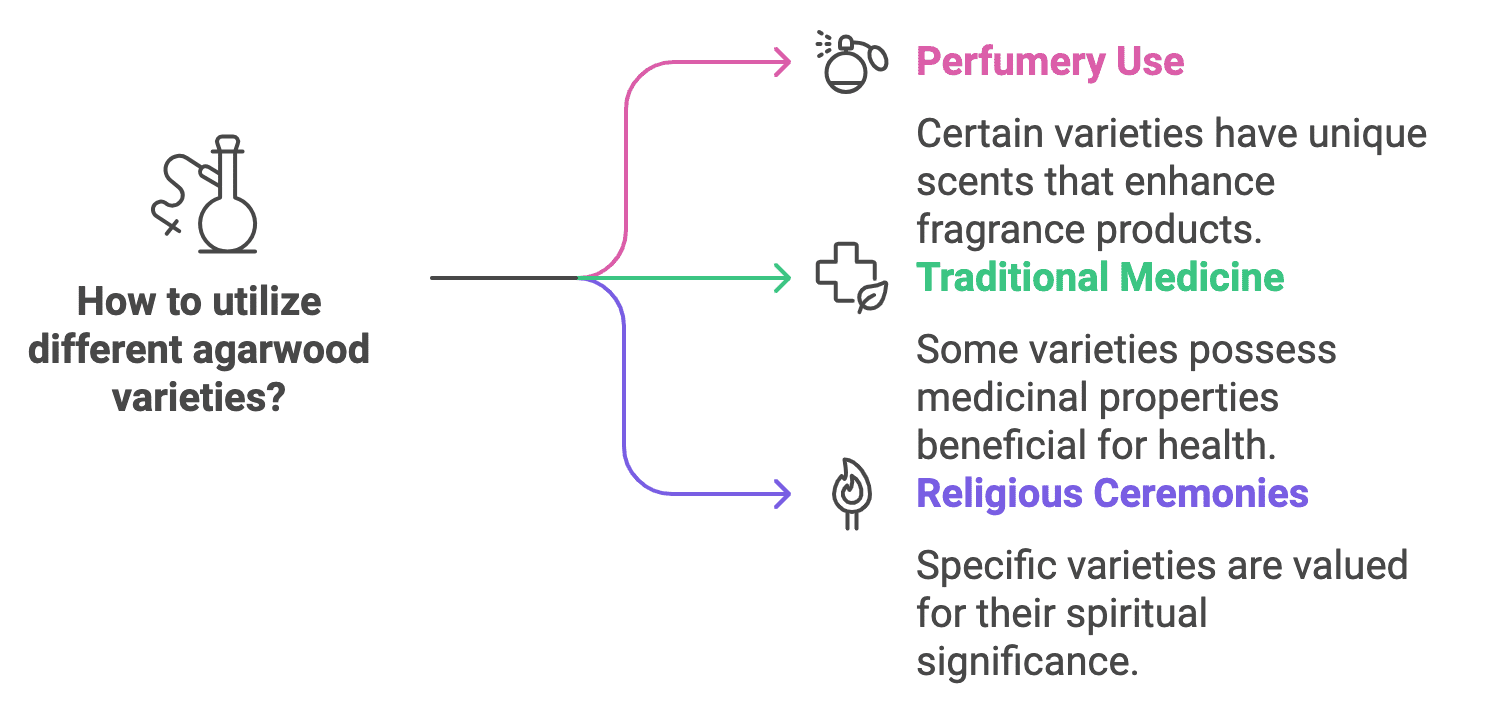
Introduction
Table of Contents
ToggleAgarwood, often referred to as the ‘wood of the gods,’ is a highly esteemed aromatic resinous wood cherished across various cultures for its captivating fragrance and multifaceted applications. Formed in the heartwood of Aquilaria trees when they become infected with a particular type of mold, agarwood develops a rich, complex aroma that has made it a valuable commodity for centuries.
Oudgo proudly celebrates this exceptional wood by offering products that capture its essence and quality. This article offers a comprehensive overview of agarwood, exploring its diverse varieties, the critical factors that determine its quality, and its distinguished place among other fragrant woods. Understanding these aspects not only highlights the cultural significance of agarwood but also sets the stage for a deeper exploration into its complex world.

II. Diversity of Agarwood Varieties
General Classification
The diversity of agarwood is a reflection of the numerous species of Aquilaria trees and the varied environmental conditions in which they grow. There are over 15 known species of Aquilaria, each contributing to the species variation in agarwood produced. Additionally, geographical factors such as soil composition, climate, and altitude influence the regional unique characteristics of agarwood, resulting in variations in scent profiles, resin content, and overall quality.

Importance of Understanding Varieties
Recognizing the diversity of agarwood is essential for appreciating its full range of qualities and applications. Different regions produce agarwood with unique attributes, which can affect its suitability for specific uses in perfumery, traditional medicine, or religious ceremonies. Understanding these varieties also aids in the conservation of Aquilaria species by highlighting the importance of preserving their natural habitats and promoting sustainable harvesting practices.

“For a detailed exploration of specific types, refer to our article on Types of Agarwood and Identification Characteristics.”
III. Evaluating Agarwood Quality
Significance of Quality Assessment
The quality determinants of agarwood are critical for consumers, traders, and producers alike. Quality directly influences the market value factors of agarwood, affecting its price and demand in global markets. High-quality agarwood is characterized by its rich aroma, high resin content, and desirable aesthetic qualities. Assessing these factors ensures that buyers receive authentic products and that the trade remains fair and transparent.

General Factors Affecting Quality
Several factors contribute to the quality of agarwood. The importance of resin concentration cannot be overstated, as the resin is responsible for the wood’s distinctive fragrance. The age of the tree and the duration of resin formation impact the depth and complexity of the aroma. Harvesting methods also play a role; sustainable and careful extraction preserves the integrity of the wood and the environment. Environmental stresses, such as natural injuries or infections, can enhance resin production, but overexploitation can threaten the survival of Aquilaria species.

“To understand the standards and grading in detail, see our article on Evaluating the Quality of Agarwood: Standards and Grading.”
IV. Agarwood Among Other Fragrant Woods
Agarwood’s Unique Position
When considering the vast array of aromatic woods, agarwood holds a unique and esteemed position. Its formation through a natural defense mechanism against mold infection results in an intricate and layered fragrance unlike any other. This uniqueness of agarwood sets it apart in the world of perfumery and incense. The wood’s rarity and the time-intensive process required for its development contribute to its high value and demand.

General Comparison with Other Woods
In an aromatic wood comparison, agarwood stands out for its complex scent profile and cultural significance. While other fragrant woods like sandalwood, cedarwood, and rosewood offer pleasant aromas and are used in similar applications, they differ in their formation processes, availability, and olfactory characteristics. The special qualities of agarwood—such as its deep, musky notes and spiritual associations—make it a prized material in ways that other woods cannot replicate.

“For a comparison with other fragrant woods, including sandalwood, read our article on Comparing Agarwood with Other Fragrant Woods.”
V. Cultural and Economic Importance
Cultural Relevance
Agarwood boasts a rich and diverse cultural heritage, deeply intertwined with religious, medicinal, and artistic traditions. Across many Asian cultures, it is revered as a sacred incense, burned during spiritual rituals to purify the surroundings and deepen meditation. Agarwood’s healing virtues are also central in traditional medicine systems like Ayurveda and Traditional Chinese Medicine.
Beyond its spiritual and medicinal roles, agarwood is highly prized in artistry and ornamentation, symbolizing wealth and status. Today, its cultural importance resonates strongly in modern markets, particularly in the realm of perfumery, where agarwood holds an esteemed place.

Economic Impact
Agarwood plays a significant role in the economies of producing countries. The trade of this valuable resource contributes to local livelihoods and can be a substantial source of revenue. However, the high demand has led to overharvesting and illegal trade, presenting sustainability challenges. Efforts to cultivate Aquilaria trees sustainably and regulate the agarwood market are essential to ensure its availability for future generations. The economic significance of agarwood thus intertwines with environmental and legal considerations, necessitating a balance between commerce and conservation.
VI. Conclusion
In summary, agarwood is a remarkable aromatic resinous wood with a diversity that spans multiple species and regions, each contributing to its unique qualities. Understanding the species variation and regional characteristics of agarwood enhances our appreciation of its value and the factors that influence its quality. The quality determinants of agarwood, such as resin concentration and harvesting methods, are crucial for maintaining its market value factors and ensuring ethical trade practices. Moreover, agarwood’s uniqueness among aromatic woods underscores its special place in cultural traditions and economic contexts.
Understanding agarwood’s multifaceted nature—from its biological formation to its profound cultural impact—highlights the importance of responsible stewardship. The sustainability challenges faced by the agarwood industry call for concerted efforts in conservation, sustainable cultivation, and legal regulation. By valuing both the tangible and intangible qualities of agarwood, we contribute to its preservation and the continuation of its cherished role in human society.
FAQs
- What is agarwood, and why is it highly valued? Agarwood is an aromatic resinous wood formed in Aquilaria trees when they become infected with a specific type of mold. It is highly valued for its rich, complex fragrance and significant cultural heritage, being used in perfumery, traditional medicine, and religious rituals.
- How does the diversity of agarwood varieties affect its quality and uses? The diversity of agarwood arises from different Aquilaria species and regional growing conditions, leading to variations in scent profiles and resin content. This affects its suitability for various applications and influences its market value factors.
- What factors are considered in evaluating the quality of agarwood? Quality determinants of agarwood include resin concentration, age of the tree, harvesting methods, and environmental stresses. These factors influence the aroma, appearance, and overall market value of the agarwood.
- How does agarwood compare to other fragrant woods? Agarwood’s uniqueness among aromatic woods lies in its complex scent profile and rare formation process. Unlike other fragrant woods like sandalwood or cedarwood, agarwood develops its aroma through a natural defense mechanism, making it particularly prized.
- What are the sustainability challenges associated with agarwood? Overharvesting and illegal trade have led to the endangerment of Aquilaria species. Sustainability challenges include the need for conservation efforts, sustainable cultivation, and adherence to legal regulations to protect this valuable resource.
Author
Tran Thi Bich Ngoc is the Head of Production at Oudgo, overseeing the entire production process from agarwood harvesting to processing and packaging the final products. She holds a Bachelor’s degree in Biotechnology from Hanoi University of Science and Technology and brings over fifteen years of experience in the agarwood production industry. Prior to joining Oudgo.Ms. Ngoc worked with companies specializing in the production of natural cosmetics and health care products. Her extensive expertise ensures the highest quality and efficiency in Oudgo’s production operations, contributing significantly to the company’s reputation for excellence see more
